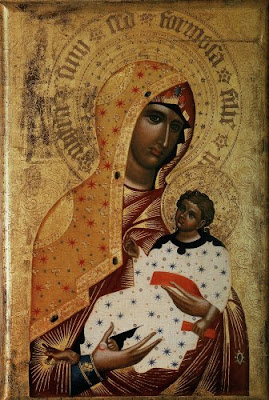O ADONAI * (December 18)
|
Latin:
O Adonai, et Dux domus Israel,
qui Moysi in igne flammae rubi apparuisti,
et ei in Sina legem dedisti:
veni ad redimendum nos in brachio extento.
|
English:
O Adonai, and leader of the House of
Israel,
who appeared to Moses in the fire of the burning bush,
and gave him the law on Sinai:
Come and redeem us with an outstretched arm.
|
Exodus 3:2 & Nehemiah 9:13
*Adonai is the plural of the Hebrew word Adon,
which means “lord” or “master.” It was first used as God's title before it was used as
God's name. The plural and capitalized Adonai is used because, according to
beliefs, God is the lord of all humanity and thus is the “lord of all lords.”
It was Adonai who led
the Chosen People out of captivity in Egypt “by the mighty arm of his power”
and gave them His law on Mount Sinai. It refers to God’s absolute
sovereignty over creation. In the New Testament, the Hebrew adonai
becomes the Greek kyrios, but the meaning—Lord—is the same, and it still
carries that sense of God's complete sovereignty over all creation.
OUR LADY OF CZESTOCHOWA, also known as the Black Madonna, is a famous painting of the Virgin Mary holding the Child Jesus. This image of Our Lady is recognized throughout the entire world, largely due to the devotion shown by the Polish St. (Pope) John Paul II.
It is located in the monastery of Jasna Gora in Poland. The painting is a significant part of Polish culture and history, and is said to have been painted by St. Luke on a table built by St. Joseph.
The painting is called the Black Madonna because of the soot that has built up on it over centuries from candles and votive lights that have been burned in front of it.
The painting has two gashes on the face of the Virgin Mary, which are said to be the result of a soldier angrily slashing the image when it was thrown on the ground to lighten the load of a wagon. The scars are said to be an integral part of the image, and even her face has the appearance of a gentle saddness, a reminder that Mary is the Mother of Sorrows.
The origin of this icon is known only in heaven. Its history before it arrived in Poland 600 years ago is shrouded in numerous legends that trace the icon's origin to St. Luke the Evangelist, who painted it on a cedar table top from the Holy Family house. Or that the painting was discovered in Jerusalem in 326 by St. Helena, who brought it back to Constantinople and presented it to her son, Constantine the Great.
The oldest documents from Jasna Góra state that the picture traveled from Constantinople via Belz. Eventually, it came into the possession of Władysław Opolczyk, Duke of Opole, and adviser to Louis of Anjou, King of Poland and Hungary.
Art historians say that the original painting was a
Byzantine icon created around the sixth or ninth century. They agree that Prince Władysław brought it to the monastery in the 14th century. The Virgin Mary is shown as the "Hodegetria" version (meaning "One Who Shows the Way" or “Οδηγήτρια” in Greek). In it, Mary directs attention away from herself, gesturing with her right hand toward Jesus as the source of salvation. In turn, the Child extends His right hand toward the viewer in blessing while holding a book of gospels in His left hand.
Ukrainians have a special devotion to the Madonna of Częstochowa. The icon is often mentioned in Ukrainian folk songs from the 16th and 17th centuries.
The feast day of Our Lady of Częstochowa is celebrated on August 26.









.jpg)


















